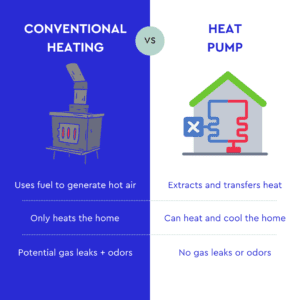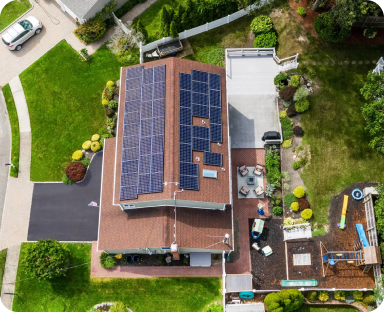Temperatures are rapidly approaching freezing and the first snow of the season is just around the corner. However, as the temperature continues to drop, the cost of heating your home is doing the opposite.
According to CNN, home heating oil is expected to skyrocket 45% this winter. The price of home heating oil recently topped $6 a gallon on Long Island, a 61% increase from this time last year. Despite the cold, some homeowners are foregoing heat as prices continue to soar. Rather than choosing between heating your home or saving money, heat pumps offer an efficient and cost-effective solution.
What is a heat pump and how does it work?
While a conventional heating system works by generating hot air from a fuel source such as oil or natural gas, heat pumps transfer heat between your home and the air outside. Like a refrigerator, heat pumps use a refrigerant that travels in coils to remove heat from the air and move it around, making the cool space cooler and adding heat to the warmer space.
Because heat pumps work by moving heat rather than creating it, they can both heat and cool your home. This can save you from purchasing separate heating and cooling systems.

There are three primary types of heat pumps: air source, water source, and geothermal. What differentiates the types are where they source their heat from. Air source heat pumps are the most common, but in this article we’ll focus on geothermal as well as they are most efficient and use less kWh, therefore lowering your carbon footprint.
Air source heat pumps
When installed correctly, an air source heat pump can deliver up to three times more energy than it consumes, making it more efficient than a conventional heating system. Additionally, an air source heat pump can reduce the amount of electricity your home uses by 50% compared to electric resistance heating (e.g. furnace, baseboard heater).
Air source heat pump technology has come a long way, functioning in lower temperatures than in the past. Advanced technology makes it a viable space heating alternative in the Northeast, which is great news for us.
Ducted vs. ductless heat pumps
A ducted heat pump is good if your home already has a duct system; otherwise, ductless heat pumps are less expensive than installing a duct system. Ductless heat pumps (also known as “mini-splits”) consist of individual units placed in different rooms of your home and can be controlled individually to heat or cool specific rooms at a time.
Geothermal heat pumps
While air source heat pumps transfer heat from the air, geothermal heat pumps (also known as ground source heat pumps) transfer heat from the ground to your home. The ground below the surface keeps a constant temperature, which is warmer than average winter temperatures and cooler than average summer temperatures. When it is 0°F outside, air source heat pumps will require about 3.6 times as much electricity as geothermal heat pumps to deliver the same amount of heat. Since geothermal/ground source heat pumps heat homes more efficiently, they also provide significantly larger savings.
A geothermal heat pump is one of the main components of the overall geothermal system used to heat your home. Underground pipes called ground loops are installed in your yard and work in combination with the geothermal heat pump to transfer heat between your home and the ground.
Incentives and rebates
Thanks to federal, state, and utility incentives, now is the best time to upgrade to an energy-efficient heating and cooling system.
The Inflation Reduction Act passed earlier this year offers rebates and tax incentives to homeowners who buy heat pumps and other clean energy technology. Starting later next year, the High Efficiency Electric Home Rebate Act (HEEHRA) will provide a deduction of up to $8,000 on heat pumps at the point of sale. The amount deducted depends on household income and the equipment chosen.
Like with solar, the Investment Tax Credit provides a 30% federal tax credit for geothermal heat pumps. Homeowners in New York who install a geothermal heat pump are also eligible for a 25% state tax credit up to $5,000.
PSEG and Con Edison have programs that offer rebates for installing heat pumps. PSEG’s Home Comfort Program air source heat pump rebates are available if you use one of their approved partners for the purchase and installation of eligible equipment. A similar PSEG program offers a rebate for ground-source heat pumps.
Con Edison offers $5,000 per 10,000 Btu/h of heating capacity off geothermal heat pumps, resulting in savings of up to 70% of project costs for all installed equipment.
Maximize your savings with solar
Although heat pumps are a cleaner source of heating and cooling, they still run on electricity, and electric bills remain high in our region. Powering your heat pump with solar panels alleviates the cost of heating and cooling and moves your home one step closer to independence from the utility grid.
Case Study: Solar + Geothermal in Islip
Tara McDermott, our Director of Customer Service and Stakeholder Relations, decided to electrify her life further when she went from oil to geothermal in 2020 after having solar for two years.
Tara has a 9.81 kW solar system on her roof, and its proposed annual yield for the first 25 years is 10,114. Tara produces most of her energy from her solar panels, so her PSEG bill is relatively low. Below is a breakdown of her total annual energy costs before and after geothermal, including her solar costs.
| Oil Used (gallon) | Oil Bills | Electric Used (kWh) | Electric Bills | Geothermal Costs | Solar Costs | Total Annual Energy Costs with Geothermal | Total Annual Energy Costs without Geothermal | |
| 2017-2018 | 720 | $2,242 | 11,196 | $983.39 | $0 | $1,000.08 | $4,225.47 | – |
| 2018-2019 | 1,169 | $3,806 | 8,580 | $194.50 | $0 | $1,500.12 | $5,500.62 | – |
| 2019-2020 | 871 | $2,647 | 8,996 | $160.26 | $0 | $1,500.12 | $4,307.38 | – |
| 2020-2021 | 578 | $1,421.31 | 15,048 | $435.60 | $972.23 | $1,500.12 | $4,329.26 | $4,767.31 |
| 2021-2022 | 0 | $0 | 21,067 | $2,028.20 | $1,666.68 | $1,500.12 | $5,195.00 | $6,795.20 |
With geothermal, Tara saved $438.05 on her annual energy costs from 2020-2021 and $1,600.20 from 2021-2022, making geothermal a worthwhile investment.
A typical single family household will use about 9,500 kWh to run a heat pump system over the course of a year. Using solar, that could cost them as low as $760 per year to run, or $2,565 without solar using energy from their electric utility. This is compared to using oil at $5 per gallon – an annual cost of $4,600 or more!
Powering a heat pump
| With solar | With energy from the electric utility | With oil |
| ~$760 / year | $2,565 / year | At least $4,600 / year |
Start saving
If you already have a solar system, it’s worth seeing if your solar panels produce enough electricity to power a heat pump system. If not, we can assess any remaining roof or ground surfaces you have and make a recommendation on adding panels to cover your new energy load.
If you’re currently looking into solar for your home, we can size your system to accommodate clean energy equipment such as heat pumps and electric vehicle charging.
Adding a battery backup system like the Tesla Powerwall will help keep your home and its appliances running during a power outage, which is especially important as extreme weather events become the new normal.
Ready to say goodbye to your high heating and electric bills? Contact us today to get started.
Stop overpaying for electric. Go solar with $0 down.

Stop overpaying for electric. Go solar with $0 down.
About the Author
EmPower Solar develops, engineers, installs, and services solar and battery systems for residential and commercial clients. Since 2003, EmPower Solar has empowered thousands of New York homeowners and businesses with 47 megawatts of distributed solar. Its vision is to create a new energy paradigm powered by clean, renewable energy for a more prosperous, healthy, and civil world. The company culture is defined by the EmPowering Way, which results in consistent 5-star customer service reviews. For more information visit empower-solar.com.